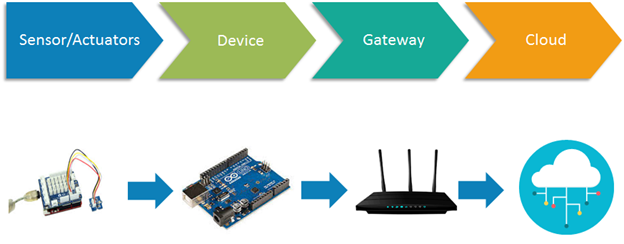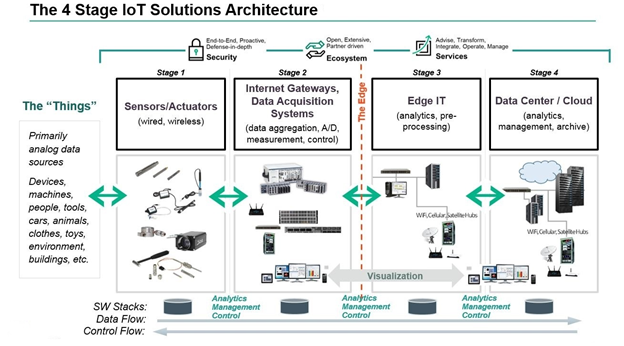Internet of Things (IoT)
Architecture & Domains
IoT Platforms
IoT + Arduino
MCQ
IoT Architecture
There is not such a unique or standard consensus on the Internet of Things (IoT) architecture which is universally defined. The IoT architecture differs from their functional area and their solutions. However, the IoT architecture technology mainly consists of four major components:
Components of IoT Architecture
- Sensors/Devices
- Gateways and Networks
- Cloud/Management Service Layer
- Application Layer

Stages of IoT Solutions Architecture
There are several layers of IoT built upon the capability and performance of IoT elements that provides the optimal solution to the business enterprises and end-users. The IoT architecture is a fundamental way to design the various elements of IoT, so that it can deliver services over the networks and serve the needs for the future.
Following are the primary stages (layers) of IoT that provides the solution for IoT architecture.
- Sensors/Actuators: Sensors or Actuators are the devices that are able to emit, accept and process data over the network. These sensors or actuators may be connected either through wired or wireless. This contains GPS, Electrochemical, Gyroscope, RFID, etc. Most of the sensors need connectivity through sensors gateways. The connection of sensors or actuators can be through a Local Area Network (LAN) or Personal Area Network.
- Gateways and Data Acquisition: As the large numbers of data are produced by this sensors and actuators need the high-speed Gateways and Networks to transfer the data. This network can be of type Local Area Network (LAN such as WiFi, Ethernet, etc.), Wide Area Network (WAN such as GSM, 5G, etc.).
- Edge IT: Edge in the IoT Architecture is the hardware and software gateways that analyze and pre-process the data before transferring it to the cloud. If the data read from the sensors and gateways are not changed from its previous reading value then it does not transfer over the cloud, this saves the data used.
- Data center/ Cloud: The Data Center or Cloud comes under the Management Services which process the information through analytics, management of device and security controls. Beside this security controls and device management the cloud transfer the data to the end users application such as Retail, Healthcare, Emergency, Environment, and Energy, etc.



